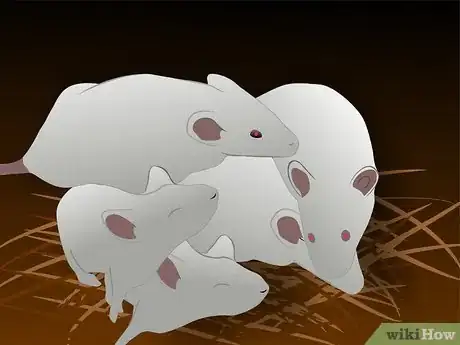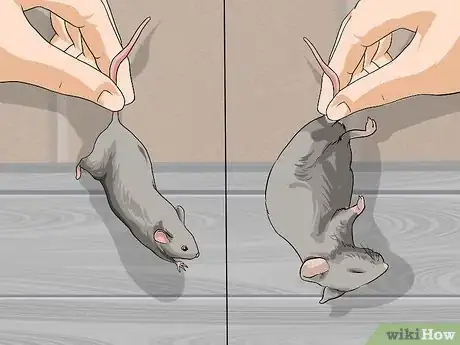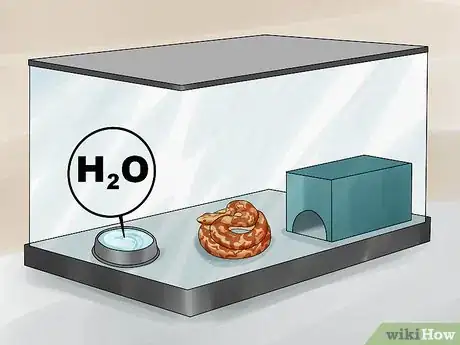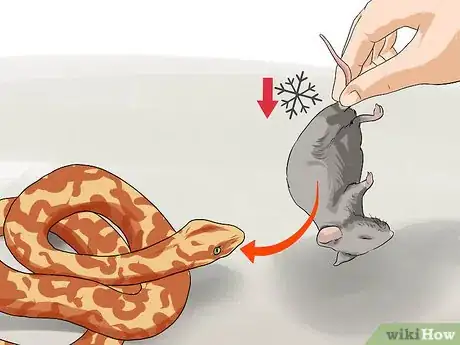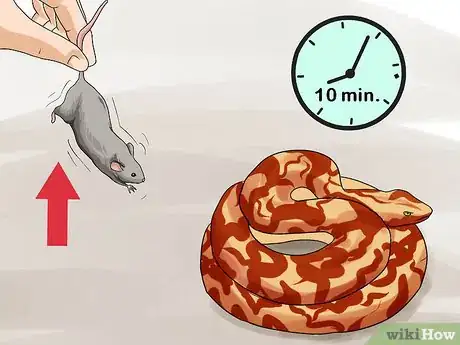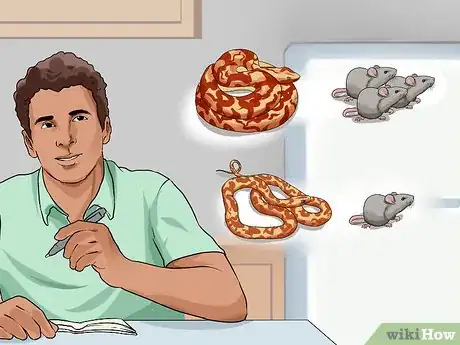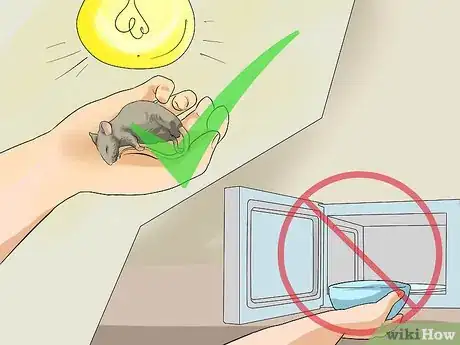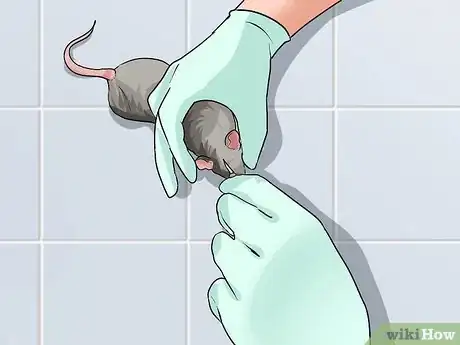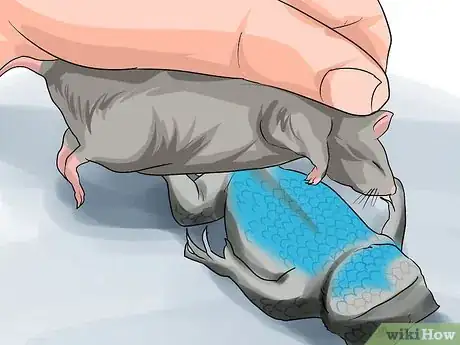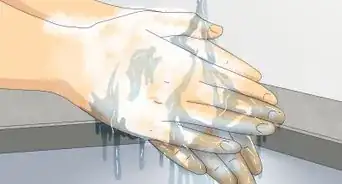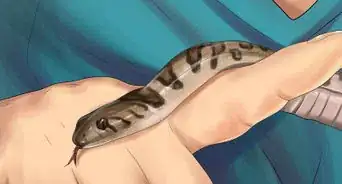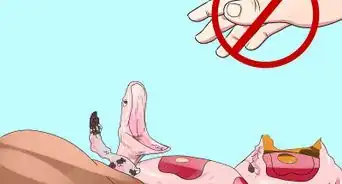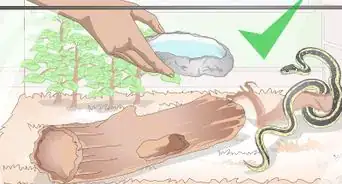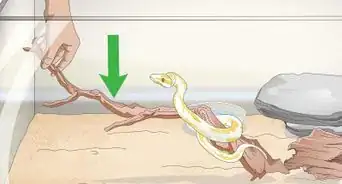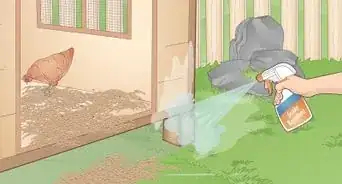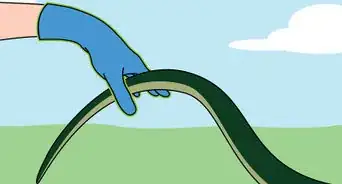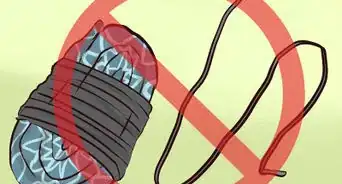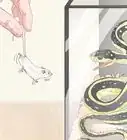This article was co-authored by Pippa Elliott, MRCVS. Dr. Elliott, BVMS, MRCVS is a veterinarian with over 30 years of experience in veterinary surgery and companion animal practice. She graduated from the University of Glasgow in 1987 with a degree in veterinary medicine and surgery. She has worked at the same animal clinic in her hometown for over 20 years.
This article has been viewed 171,470 times.
Snakes are natural hunters, and in captivity their healthiest food source are rats or mice. These can be fed to your snake either live or frozen then thawed. You can raise your own prey for your snake or buy it from a pet store. Be sure to choose the size that's right for your snake's age and species.
Steps
Choosing the Right Food
-
1Purchase mice or rats. In the wild, most snakes eat mice, rats, or other small rodents. These animals meet all of snakes' nutritional needs, so an all-mice or all-rat diet is completely sufficient to keep your snake healthy and happy. If you have just one snake to feed, you can purchase mice or rats from a local pet store. If you have a large number of snakes, you might consider breeding mice or rats for feeding purposes.
- Be sure to purchase mice from a company you trust. Make sure the mice were fed properly and not treated with chemicals.
- If you don't want to feed your snake rats or mice, you will have to gut it out or have someone else feed the snake. All large snakes need rats or mice and lots of smaller ones do too.
- While some snakes can live off insects, they will never be happy or very healthy on an all insects diet. Always feed rodents to your snake. [1]
- Don't feed a snake live crickets, since crickets can eat its scales and harm the snake.[2]
-
2Choose between live or frozen. As snakes' popularity as pets has risen, more food product options have become available in pet stores. Many pet owners choose to buy live mice or rats to feed their snakes, but getting frozen rats that you serve thawed and warmed is a viable, convenient, and safer option. Do some research and decide which method is right for you and the needs of your snake.
- If you choose to offer live mice, you'll be able to more accurately replicate the snake's feeding habits in the wild. However, using live mice creates the need for a lot of extra effort on your part. You'll need to either breed mice or run to the store to get more every few days. And if you put a live mouse in the cage when the snake isn't in the mood to eat, you'll have to take it back out and store it until you can try again.
- Many find that using frozen and thawed mice or rats is more convenient and safer for the snake to eat. The drawback is that since this isn't how snakes acquire food in the wild, it can take some time before the snake is comfortable eating a dead carcass instead of catching its food live; however, keep in mind feeding pre-killed rodent will prevent your snake from being harmed or even in some cases killed by their prey if they were to fight back.
- Many snakes start on live mice as babies and then can be worked toward frozen mice as they get older.
Advertisement -
3Get the right size food for your snake. Mice and rats are sold according to their size. Baby snakes and small snakes need smaller prey than larger snakes, which prefer large mice or rats. As your snake grows, you'll need to provide bigger prey, but prey that's too large can be hard on a snake's digestive system. A good rule of thumb is to choose food that's the same circumference as the largest part of your snake's body. The different sizes of food available are as follows:[3]
- Pinkies: these are baby mice, called "pinkies" because they have yet to grow fur. Pinkies are good for baby snakes and small adults. For the smallest baby snakes, pinky parts are available.
- Fuzzies: these are baby mice that have just acquired their first signs of fur. They're a little larger, so they're best for either large baby snakes, like boas, rat snakes, milk snakes, or medium adult snakes.
- Hoppers: these are adult mice, sufficient for baby ball pythons (which are quite large) and most adult snakes.
- Rat pups and full-sized rats: this is the biggest prey available, and should be reserved for large adult snakes.
-
4Provide water as well. A bowl of water large and deep enough for the snake to completely submerge itself is good. Snakes don't drink often, but they need to submerge their bodies in water from time to time to stay healthy, and promote clean shedding.
- Make sure the bowl stays clean. It should be disinfected every few weeks to kill bacterial growth.
Feeding the Snake
-
1Prepare the food. If you're using live food, no preparation is necessary as long as the food was raised in sanitary conditions. Frozen food, however, needs to be thawed properly and heated to a temperature that makes it more appealing for a snake. If you're using frozen pinkies, fuzzies, hoppers or rats, follow this method for thawing and preparing the food:
- Lay the frozen food on a paper towel and set it near a fan. The small body will quickly thaw. Optionally you can put the food in a plastic bag and then submerge it in warm water. Thawing can take anywhere from 10 minutes to a few hours depending on method and size of food. Check every so often to make sure the food is thoroughly thawed. Thaw only as much as you need for one feeding.
- Heat the food. Many snakes won't eat if they can't sense the correct temperature that mimics a live food. You can heat the food in a bag with hot water or use a blow dryer for about ten minutes. Never use a microwave or oven as this can cause the food to explode.
-
2Offer thawed prey to the snake. You'll have to get to know your snake before landing on the best way to offer food. Some snakes prefer to have the food set into the cage so they can find it for themselves, while others prefer to have it dangled in the cage, attracted by the movement this creates. Try both methods to figure out what works best for your snake.
- When you offer food by placing it in the cage, you may put it on a small plate or in a shallow bowl that will keep it separate from the snake's bedding. A snake may rarely swallow its bedding.
- When you offer food by dangling it in the cage, use a pair of tweezers or forceps. Some use their hands, but this is not recommended. Snakes with a strong feeding response may accidentally bite you confusing your hand's heat or mixed smell with the food's.
- Whichever method you choose, give the snake time to decide to eat. Research your snake's species. Some may feed within a few minutes, but others (like ball pythons) may require leaving the thawed food in overnight. For most cases, if the snake does not eat the food over a short period, it may be re-frozen for later use if it is still fresh and not spoiled.
-
3Remove live prey promptly. Allow the snake to feed for approximately ten minutes, then remove the food. Never leave your snake unattended with a live feeder. If the snake isn't hungry and the prey stays in the cage, it might try to bite or scratch the snake, in an attempt to save itself. Place the prey back in a holding container and try again next scheduled feeding.
-
4Create an age and size-based feeding schedule, based on your snake's species. In general, baby snakes generally only need food about once a week. As they get larger and older, snakes need to be fed less often (keeping in mind the feeder will be larger). Be sure to check out some care sheets and do your research to see how often and at what sizes you should be feeding your snake.
- As you change the feeding schedule, keep in mind that you shouldn't try to force a snake to eat. Offer the food, then take it away if it isn't wanted.
- Look into the regular feeding intervals for your type of snake. Some snakes may eat once a week, other may eat only eat once a month or a few times a year.
Handling a Picky Eater
-
1Make sure the food is warm enough. If you're serving frozen and thawed mice, it's important to heat them enough so that they seem as though they're still alive or were just recently killed. This is especially important for boas and pythons, which have receptors in their faces that can sense heat coming from their prey, triggering a feeding response.[4]
- Try holding the prey against a warm light bulb for a few moments before offering it.
- Don't heat mice in the microwave unless you have one reserved for that specific purpose. If you use a microwave, use very low power setting.
-
2Consider the braining technique. Puncturing the prey's brain releases a scent that can help it seem more attractive to a snake. This technique can be used on dead mice, though it's not easy to do if you're squeamish. If you wish to try this method, use the following steps:[5]
- Insert a sharp knife or scalpel into the mouse's frontal lobe, at the top of the head.
- Insert a toothpick into the would and draw out brain matter.
- Smear the brain matter on the mouse's nose.
-
3Try rubbing it with a lizard. It sounds strange, but you can make a dead mouse more appetizing to a snake if you rub it with the body of a lizard. Purchase a dead anole, swift, or fence lizard from the pet store and apply its scent to the body of the mouse. While this method isn't really feasible to use every time you need to feed the snake, it's a good way to get the snake used to eating the food you're offering.
- This is a particularly good method to use when you're introducing a snake used to eating live mice to frozen food. It can take a few tries to get the snake used to eating food that has already been killed.[6]
- Other methods of helping a picky eater include changing feeder size or color. Also try changing types of feeder (ie. if you tried a rat, try something else like a mouse, gerbil, etc.). Try turning off the lights. Some snakes, like ball pythons, are nocturnal are more active during the evening or at night. You can also try dipping the feeder in chicken broth. Try rubbing the scent of another animal on your feeder (ie. used bedding from gerbils/hamsters/etc.).
Warnings
- Its illegal to feed live prey in some areas because of the danger to predator as well as the unnecessary suffering caused to the prey. So before you live feed, ask your breeder if they feed their snakes thawed before you attempt live prey.⧼thumbs_response⧽
- Be aware that feeding live prey to your snake is dangerous to the snake. Prey can and will fight back to protect themselves which will potentially cause serious injury to your snake. Sometimes if the snake isn't hungry it will ignore the mouse, but the mouse will gnaw or bite on it and cause serious injuries. Never leave your snake unattended with a live feeder!⧼thumbs_response⧽
- It shortens a snakes lifespan by feeding them live mice instead of frozen. This is because when attacked, endorphin and thiamine levels of the mouse or rat really heighten and thiamine levels can be harmful to snakes. When a mouse or rat is killed humanely, they become unconscious before the body goes into shock and creates these chemicals so the snake isn't digesting harmful levels of these toxins.⧼thumbs_response⧽
References
About This Article
To feed a snake, start by getting mice or rats from a local pet store that are alive or frozen. Make sure the rodents are no bigger than the largest part of your snake's body or it may have trouble digesting them. If you're using frozen prey, thaw it and heat it in hot water before feeding it to your snake. If you're using live prey, drop it into your snake's cage and take it out if your snake hasn't eaten it within 10 minutes. For help determining how often you should feed your snake, scroll down!
